1. What are two reasons for creating an OSPF networkWhat information is contained within an OSPF type 4 LSA with multiple areas? (Choose two.)
- to simplify configuration
- to reduce SPF calculations
- to reduce use of memory and processor resources
- to provide areas in the network for routers that are not running OSPF
- to ensure that an area is used to connect the network to the Internet
2. What is used to facilitate hierarchical routing in OSPF?
- requent SPF calculations
- autosummarization
- the election of designated routers
- the use of multiple areas
3. A network administrator is verifying a multi-area OSPF configuration by checking the routing table on a router in area 1. The administrator notices a route to a network that is connected to a router in area 2. Which code appears in front of this route in the routing table within area 1?
- C
- O
- O IA
- O E2
4. Which two statements correctly describe OSPF type 3 LSAs? (Choose two.)
- Type 3 LSAs are known as autonomous system external LSA entries.
- Type 3 LSAs are known as router link entries.
- Type 3 LSAs are used for routes to networks outside the OSPF autonomous system.
- Type 3 LSAs are used to update routes between OSPF areas.
- Type 3 LSAs are generated without requiring a full SPF calculation.
5. Which characteristic describes both ABRs and ASBRs that are implemented in a multiarea OSPF network?
- They are required to reload frequently and quickly in order to update the LSDB.
- They both run multiple routing protocols simultaneously.
- They are required to perform any summarization or redistribution tasks.
- They usually have many local networks attached.
6. What type of OSPF LSA is originated by ASBR routers to advertise external routes?
- type 5
- type 2
- type 3
- type 1
7. What OSPF LSA type is used to inform routers of the router ID of the DR in each multiaccess network in an OSPF area?
- type 3
- type 2
- type 1
- type 4
8. Refer to the exhibit. Which two statements are correct? (Choose two.)
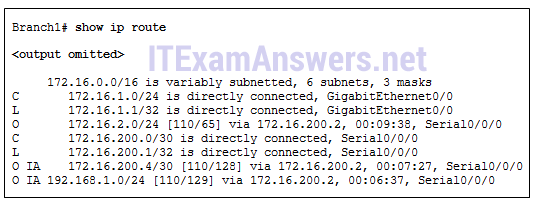
- To reach network 192.168.1.0, traffic will exit via the Serial0/0/0 interface.
- The entry for 172.16.200.1 represents a loopback interface.
- To reach network 172.16.2.0, traffic will travel through the GigabitEthernet0/0 interface.
- The routing table contains two intra-area routes.
- The routing table contains routes from multiple areas.
9. What information is contained within an OSPF type 4 LSA?
- summarized routes from other areas
- the RID of the DR
- the route to an ABR
- the route to an ASBR
10. Which type of OSPF router has interfaces connected to multiple OSPF areas?
- BDR
- ABR
- ASBR
- DR
11. What routing table descriptor is used to identify OSPF summary networks that originate from an ABR?
- O IA
- O E1
- O E2
- O
12. The graphic shows the partial output of the show ip route command:
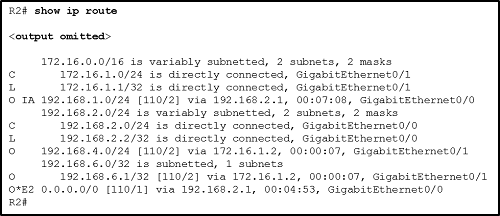
Refer to the exhibit. What can be concluded about network 192.168.4.0 in the R2 routing table?
- The network was learned through summary LSAs from an ABR.
- The network can be reached through the GigabitEthernet0/0 interface.
- The network was learned from a router within the same area as R2.
- This network should be used to forward traffic toward external networks.
13. Launch PT Hide and Save PT

Open the PT Activity. Perform the tasks in the activity instructions and then answer the question. What is preventing users who are connected to router R2 from accessing resources located either within the network 192.168.1.0 or the internet?
- The router R2 is not receiving any updates from either router R1 or R3.
- The default route is not redistributed correctly from the router R1 by OSPF.
- The OSPF timers that are configured on routers R1, R2, and R3 are not compatible.
- The interface that is connected to the ISP is down.
- The OSPF network statements are misconfigured on one of the routers.
14. Which three steps in the design and implementation of a multiarea OSPF network are considered planning steps? (Choose three.)
- Troubleshoot the configurations.
- Define the network requirements.
- Configure OSPF.
- Gather the required parameters.
- Verify OSPF.
- Define the OSPF parameters.
15. Which two networks are part of the summary route 192.168.32.0/22? (Choose two.)
- 192.168.35.0/24
- 192.168.38.0/24
- 192.168.37.0/24
- 192.168.36.0/24
- 192.168.33.0/24
- 192.168.31.0/24
16. Refer the the exibit. What is the role of router R2 in the OSPF domain?
- BDR
- DR
- ABR
- ASBR
17. Refer to the exhibit. What is indicated by the O IA in the router output?
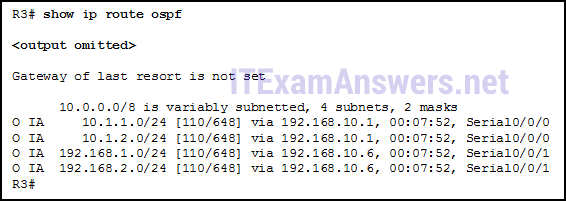
- The route was manually configured.
- The route was learned from outside the internetwork.
- The route was learned from within the area.
- The route was learned from another area.
18. Which type of OSPF router will generate type 3 LSAs?
- BDR
- DR
- ASBR
- ABR
19. Which type of OSPF LSA is generated by an ASBR and includes external routes?
- type 2
- type 4
- type 3
- type 5
20. Refer to the exhibit. A network administrator has been asked to summarize the networks shown in the exhibit as part of a multiarea OSPF implementation. All addresses are using a subnet mask of 255.255.255.0. What is the correct summarization for these eight networks?
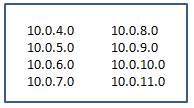
- 10.0.4.0 255.255.0.0
- 10.0.0.0 255.255.240.0
- 10.0.4.0 255.255.248.0
- 10.0.8.0 255.255.248.0
21. What are two reasons for creating an OSPF network with multiple areas? (Choose two.)
- to simplify configuration
- to ensure that an area is used to connect the network to the Internet
- to reduce SPF calculations
- to provide areas in the network for routers that are not running OSPF
- to reduce use of memory and processor resources
22. Refer to the exibit. What is the role of router R2 in the OSPF domain?
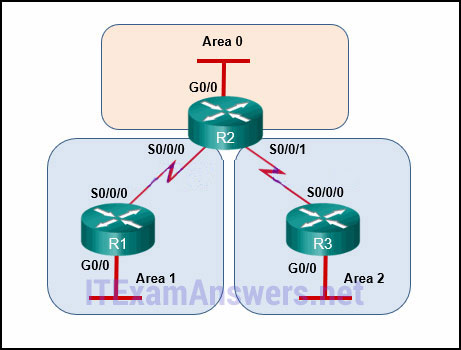
- DR
- BDR
- ASBR
- ABR
23. The network administrator has been asked to summarize the routes for a new OSPF area. The networks to be summarized are 172.16.8.0, 172.16.10.0, and 172.16.12.0 with subnet masks of 255.255.255.0 for each network. Which command should the administrator use to forward the summary route for area 15 into area 0?
- area 15 range 172.16.8.0 255.255.255.248
- area 0 range 172.16.8.0 255.255.255.248
- area 0 range 172.16.8.0 255.255.248.0
- area 15 range 172.16.8.0 255.255.248.0
24. Question as presented:
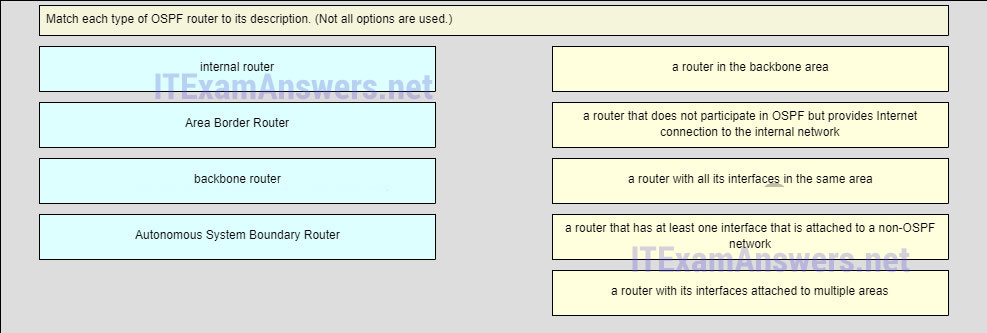
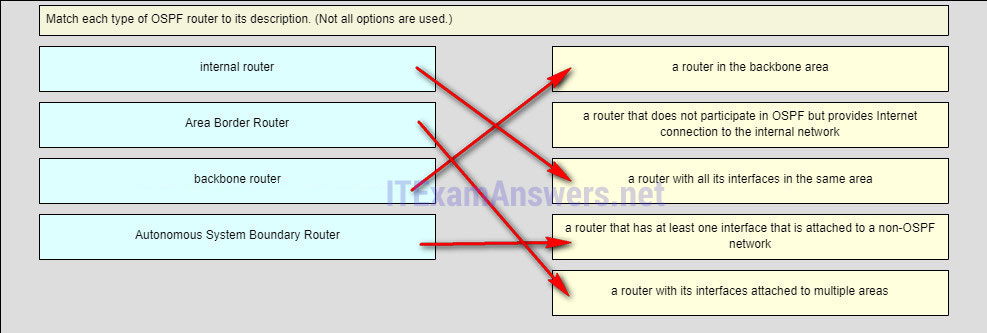
25. Fill in the blank. Do not use acronyms.
OSPF type 2 LSA messages are only generated by the designated* router to advertise routes in multiaccess networks.
26. Fill in the blank. Use a number.
An ASBR generates type 5* LSAs for each of its external routes and floods them into the area that it is connected to.
27. Fill in the blank. Use a number.
A type 4* LSA identifies the ASBR and provides a route to it.
28. Refer to the exhibit. Fill in the blank. Do not use abbreviations.
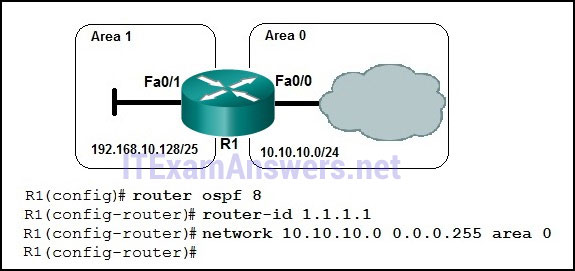
The network 192.168.10.128 0.0.0.127 area 1* command must be issued to configure R1 for multiarea OSPF.
29. Open the PT Activity. Perform the tasks in the activity instructions and then answer the question. Why are users in the OSPF network not able to access the Internet?
- The default route is not redistributed correctly from router R1 by OSPF.
- The network statement is misconfigured on router R1.
- The OSPF network statements are misconfigured on routers R2 and R3.
- The OSPF timers that are configured on routers R1, R2, and R3 are not compatible.
- The interface that is connected to the ISP router is down.
30. Open the PT Activity. Perform the tasks in the activity instructions and then answer the question.
Fill in the blank. Do not use abbreviations.
What is the missing command on router R2 to establish an adjacency between routers R1 and R3?
network 172.16.10.0 0.0.0.255 area 0*
Older Version
31. Which IOS 12.4 software package integrates full features, including voice, security, and VPN capabilities, for all routing protocols?
- Advanced Security
- Advanced IP Services
- Advanced Enterprise Services
- Service Provider Services
32. What is the major release number in the IOS image name c1900-universalk9-mz.SPA.152-3.T.bin?
- 2
- 3
- 15
- 52
- 1900
33. What statement describes a Cisco IOS image with the “universalk9_npe” designation for Cisco ISR G2 routers?
- It is an IOS version that can only be used in the United States of America.
- It is an IOS version that provides only the IPBase feature set.
- It is an IOS version that offers all of the Cisco IOS Software feature sets.
- It is an IOS version that, at the request of some countries, removes any strong cryptographic functionality.
34. Which statement describes a difference between the IOS 15.0 extended maintenance release and a standard maintenance release?
- They consist of two separate parallel trains.
- The extended maintenance release will deliver new IOS features as soon as they are available.
- The standard maintenance release enables faster IOS feature delivery than the extended maintenance release does.
- A new standard maintenance release will synchronize with the latest extended maintenance release before the extended is made available.
35. When a router is powered on, where will the router first search for a valid IOS image to load by default?
- RAM
- ROM
- flash memory
- NVRAM
36. A network engineer is upgrading the Cisco IOS image on a 2900 series ISR. What command could the engineer use to verify the total amount of flash memory as well as how much flash memory is currently available?
- show flash0:
- show version
- show interfaces
- show startup-config
37. The customer of a networking company requires VPN connectivity for workers who must travel frequently. To support the VPN server, the customer router must be upgraded to a new Cisco IOS software version with the Advanced IP Services feature set. What should the field engineer do before copying the new IOS to the router?
- Set the router to load the new IOS image file directly from the TFTP server on the next reboot.
- Delete the currently installed IOS by using the erase flash: command, and reload the router
- Issue the show running-configuration command to determine the features of the currently installed IOS image file.
- Issue the show version and the show flash commands to ensure that the router has enough memory and file space to support the new IOS image.
38. A network administrator configures a router with the command sequence:
R1(config)# boot system tftp://c1900-universalk9-mz.SPA.152-4.M3.bin
R1(config)# boot system rom
What is the effect of the command sequence?
- On next reboot, the router will load the IOS image from ROM.
- The router will copy the IOS image from the TFTP server and then reboot the system.
- The router will load IOS from the TFTP server. If the image fails to load, it will load the IOS image from ROM.
- The router will search and load a valid IOS image in the sequence of flash, TFTP, and ROM.
39. Beginning with the Cisco IOS Software Release 15.0, which license is a prerequisite for installing additional technology pack licenses?
- IPBase
- DATA
- UC
- SEC
40. Which three software packages are available for Cisco IOS Release 15.0?
- DATA
- IPVoice
- Security
- Enterprise Services
- Unified Communications
- Advanced IP Services
41. When a customer purchases a Cisco IOS 15.0 software package, what serves as the receipt for that customer and is used to obtain the license as well?
- Software Claim Certificate
- End User License Agreement
- Unique Device Identifier
- Product Activation Key
42. Which command would a network engineer use to find the unique device identifier of a Cisco router?
- show version
- show license udi
- show running-configuration
- license install stored-location-url
43. A newly hired network engineer wants to use a 2911 router from storage. What command would the technician use to verify which IOS technology licenses have been activated on the router?
- show flash0:
- show interfaces
- show license
- show startup-config
- show version
44. Which command is used to configure a one-time acceptance of the EULA for all Cisco IOS software packages and features?
- license save
- show license
- license boot module module-name
- license accept end user agreement
45. How long is the evaluation license period for Cisco IOS Release 15.0 software packages?
- 15 days
- 30 days
- 60 days
- 180 days
46. What is the purpose of a T train release in Cisco IOS 15?
- It is used for long-term maintenance, enabling customers to qualify, deploy, and remain on the release for an extended period.
- It provides regular bug fix maintenance rebuilds, plus critical fix support for network-affecting bugs.
- It provides premium packages and enables additional IOS software feature combinations that address more complex network requirements.
- It specifies advanced IP services features such as advanced security and service provider packages.
47. What code in the Cisco IOS 15 image filename c1900-universalk9-mz.SPA.153-3.M.bin indicates that the file is digitally signed by Cisco?
- SPA
- universalk9
- M
- mz
48. What statement describes a Cisco IOS image with the “universalk9_npe” designation for Cisco ISR G2 routers?
- It is an IOS version that, at the request of some countries, removes any strong cryptographic functionality.
- It is an IOS version that provides only the IPBase feature set.
- It is an IOS version that offers all of the Cisco IOS Software feature sets.
- It is an IOS version that can only be used in the United States of America.
49. How long is the evaluation license period for Cisco IOS Release 15.0 software packages?
- 30 days
- 15 days
- 60 days
- 180 days
50. Fill in the blank. Do not use abbreviations.
The license “install” flash0:seck9-C1900-SPE150_K9-FAB12340099.xml command will restore the specified saved Cisco IOS Release 15 license to a router.
51. Refer to the exhibit. Match the components of the IOS image name to their description. (Not all options are used.)

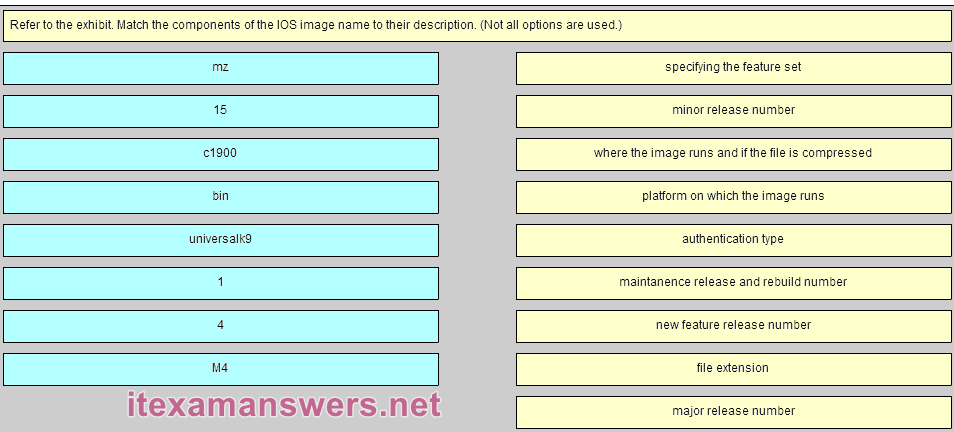
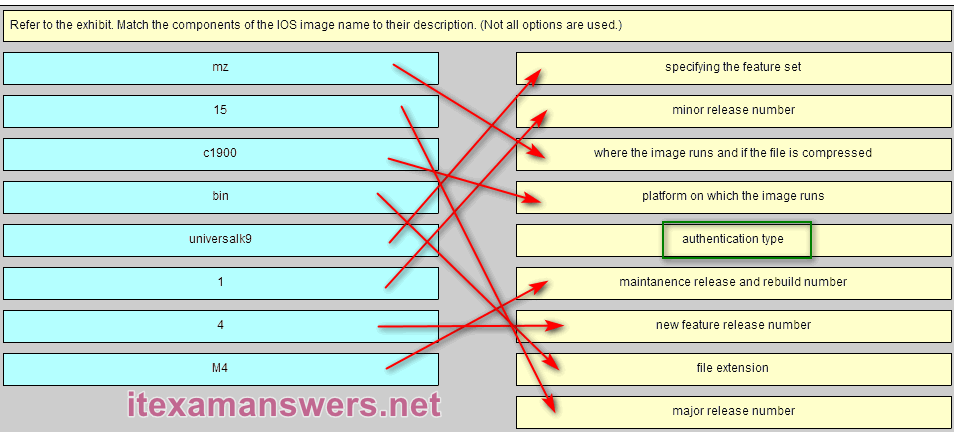
Place the options in the following order:
specifying the feature set -> universalk9
minor release number -> 1
where the image runs and if the file is compressed -> mz
platform on which the image runs -> c1900
– not scored –
maintanence release and rebuild number -> M4
new feature release number -> 4
file extension -> bin
major release number -> 15
52. Match the description to the Cisco IOS category. (Not all options apply.)


Place the options in the following order:
technology train
[+] branches from another train
[+] has the latest features
mainline train
[#] possibly is 12.4
[#] contains mostly bug fixes
- 53. Refer to the exhibit. Which of the three Cisco IOS images shown will load into RAM?
The router selects the second Cisco IOS image because it is the smallest IOS image. - The router selects an image depending on the boot system command in the configuration
- The router selects the third Cisco IOS image because it contains the advipservicesk9 image.
- The router selects the third Cisco IOS image because it is the most recent IOS image.
- The router selects an image depending on the value of the configuration register.
54. In addition to IPBase, what are the three technology packs that are shipped within the universal Cisco IOS Software Release 15 image? (Choose three.)
- Advanced IP Service
- SP Services
- Unified Communications
- Security
- DATA
55. What code in the Cisco IOS 15 image filename c1900-universalk9-mz.SPA.153-3.M.bin indicates that the file is digitally signed by Cisco?
- M
- universalk9
- mz
- SPA
56. Which two conditions should the network administrator verify before attempting to upgrade a Cisco IOS image using a TFTP server? (Choose two.)
- Verify the name of the TFTP server using the show hosts command.
- Verify that the TFTP server is running using the tftpdnld command.
- Verify that the checksum for the image is valid using the show version command.
- Verify connectivity between the router and TFTP server using the ping command.
- Verify that there is enough flash memory for the new Cisco IOS image using the show flash command.
57. Which three images are considered premium software packages for Cisco IOS Release 12.4? (Choose three.)
- IP Voice
- Enterprise Base
- Advanced Security
- Enterprise Services
- Advanced IP Services
- Advanced Enterprise Services
58. A network technician is troubleshooting problems with a router that is running IOS 15. Which command will display the features activated for the licenses that are installed on the router?
- show flash0:
- show license
- show startup-config
- show version
59. Match each type of OSPF router to its description. (Not all options are used.)


internal router ~~> 3.a router with all its interfaces in the same area*
area border router ~~> 5.a router with its interfaces attached to multiple areas*
backbone router ~~> 1. a router in the backbone area*
autonomous system boundary router ~~> 4. a router that has at least one interface that is attached to a non-OSPF network*
Download PDF File below:

how to open incognito tab pls help me
Hello,
Also I had a question that it is not found here.
Good luck to everyone!
Thanks you!
Match each type of OSPF router to its description. (Not all options are used.)
—–
internal router
area border router
backbone router
autonomous system boundary router
——
1. a router in the backbone area
2. a router that does not participate in OSPF but provides Internet connection to the internal network
3. a router with all its interfaces in the same area
4. a router that has at least one interface that is attached to a non-OSPF network
5.a router with its interfaces attached to multiple areas
updated
Match each type of OSPF router to its description. (Not all options are used.)
a router in the backbone area => backbone router
a router with all its interfaces in the same area => internal router
a router that has at least one interface that is attached to a non-OSPF network => Autonomous System Boundary Router
a router with its interfaces attached to multiple areas => Area Border Router
8
The graphic shows the partial output of the show ip route command:
R2# show ip route
172.16.0.0/16 is variably subnetted, 2 subnets, 2 masks
C 172.16.1.0/24 is directly connected, GigabitEthernet0/1
L 172.16.1.1/32 is directly connected, GigabitEthernet0/1
O IA 192.168.1.0/24 [110/2] via 192.168.2.1, 00:07:08, GigabitEthernet0/0
192.168.2.0/24 is variably subnetted, 2 subnets, 2 masks
C 192.168.2.0/24 is directly connected, GigabitEthernet0/0
L 192.168.2.2/32 is directly connected, GigabitEthernet0/0
O 192.168.4.0/24 [110/2] via 172.16.1.2, 00:00:07, GigabitEthernet0/1
192.168.6.0/32 is subnetted, 1 subnets
O 192.168.6.1/32 [110/2] via 172.16.1.2, 00:00:07, GigabitEthernet0/1
O*E2 0.0.0.0/0 [110/1] via 192.168.2.1, 00:04:53, GigabitEthernet0/0
R2#
Refer to the exhibit. What can be concluded about network 192.168.4.0 in the R2 routing table?
The network can be reached through the GigabitEthernet0/0 interface.
The network was learned through summary LSAs from an ABR.
This network should be used to forward traffic toward external networks.
The network was learned from a router within the same area as R2.
Match each type of OSPF router to its description. (Not all options are used.)
internal router
Area Border Router
backbone router
Autonomous System Boundary Router
a router in the backbone area
a router that does not participate in OSPF but provides Internet connection to the internal network
a router with all its interfaces in the same area
a router that has at least one interface that is attached to a non-OSPF network
a router with its interfaces attached to multiple areas
9
What information is contained within an OSPF type 4 LSA?
summarized routes from other areas
the RID of the DR
the route to an ABR
the route to an ASBR
6
Which type of OSPF router has interfaces connected to multiple OSPF areas?
BDR
ABR
ASBR
DR
12
Open the PT Activity. Perform the tasks in the activity instructions and then answer the question.
What is preventing users who are connected to router R2 from accessing resources located either within the network 192.168.1.0 or the internet?
The router R2 is not receiving any updates from either router R1 or R3.
The OSPF network statements are misconfigured on one of the routers.
The interface that is connected to the ISP is down.
The OSPF timers that are configured on routers R1, R2, and R3 are not compatible.
The default route is not redistributed correctly from router R1 by OSPF.
14
Which type of OSPF router will generate type 3 LSAs?
BDR
DR
ASBR
ABR
15
Which type of OSPF LSA is generated by an ASBR and includes external routes?
type 2
type 4
type 3
type 5
Refer the the exibit. What is the role of router R2 in the OSPF domain?
BDR
DR
ASBR
ABR
I can provide picture of the refer to the exhibit question
Thanks for reply. You can attach the file in the comment form :)
ABR
12. Refer to the exhibit. Which of the three Cisco IOS images shown will load into RAM?
(The router selects an image depending on the boot system command in the configuration).